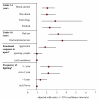Early pubertal onset and its relationship with sexual risk taking, substance use and anti-social behaviour: a preliminary cross-sectional study
- PMID: 19958543
- PMCID: PMC3091535
- DOI: 10.1186/1471-2458-9-446
Early pubertal onset and its relationship with sexual risk taking, substance use and anti-social behaviour: a preliminary cross-sectional study
Abstract
Background: In many countries age at pubertal onset has declined substantially. Relatively little attention has been paid to how this decline may affect adolescent behaviours such as substance use, violence and unprotected sex and consequently impact on public health.
Methods: In the UK, two opportunistic samples (aged 16-45 years), paper-based (n = 976) and online (n = 1117), examined factors associated with earlier pubertal onset and whether earlier age of onset predicted sexual risk-taking, substance use and anti-social behaviours during early adolescence.
Results: Overall, 45.6% of females reported menarche < or = 12 years and 53.3% of males were categorised as having pubertal onset < or = 11 years. For both sexes earlier pubertal onset was associated with poorer parental socio-economic status. Other pre-pubertal predictors of early onset were being overweight, more childhood illnesses (females) and younger age at time of survey (males). For both sexes earlier puberty predicted having drunk alcohol, been drunk, smoked and used drugs <14 years as well as having a sexual debut and unprotected sex <16 years. Males with earlier pubertal onset were more likely to report fighting and aggressive responses to emotional upset during early adolescence while females were more likely to report being bullied and having taken more time off school.
Conclusion: Results provide sufficient evidence for changes in age of pubertal onset to be further explored as a potential influence on trends in adolescent risk behaviours. Further insight into the relationship between early puberty and both obesity and socio-economic status may help inform early interventions to tackle the development of risk behaviours and health inequalities during early adolescence.
Figures


References
Publication types
MeSH terms
LinkOut - more resources
Full Text Sources
Medical

